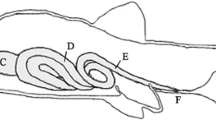Abstract
The digestive microflora produces a decrease of the mucosal histamine content in the wall of the chicken colon but has no significant incidence in the upper part of the digestive tract.
The anatomical and physiological particularities of the chicken digestive tract permitted to observe that wall histamine concentration depends on different factors. Endogenous factors control the wall histamine content in the proventriculus, independantly of the diet and/or of the presence of a microflora. Diet has a specific incidence upon the gastrointestinal wall of the host in the crop and in the colon. The colon microflora decreases the effect of the diet essentially when the chicken are fed a semi synthetic diet. Interactions between the diet and the microflora could induce physiopathological manifestations.
Similar content being viewed by others
References
M. H. Beaver and B. S. Wostmann,Histamine and 5-hydroxytryptamine in the intestinal tract of germ-free animals, animals harbouring one microbial species and conventional animals. Br. J. Pharmacol.19, 385–393 (1962).
G. D. Abrams, H. Bauer and H. Sprink,Influence of the normal flora on mucosa morphology and cellular renewal in the ileum. A comparison of germ-free and conventional mice. Lab. Invest.12, 355–364 (1963).
J. M. Wal, J. C. Meslin, A. Weyer and B. David,Histamine and mast cell distribution on the gastrointestinal wall of the rat: comparison between germ-free and conventional rats. Int. Archs Allergy Appl. Immun.77, 308–314 (1985).
Z. Horakova, Ch. Zierdt and M. A. Beaven,Identification of lactobacillus as the source of bacterial histidine decarboxylase in rat stomach. Eur. J. Pharmacol.16, 67–77 (1971).
M. R. Popoff, O. Szylit, P. Ravisse, J. Dabard and H. Ohayoun,Experimental cecitis in gnotoxenic chickens monoassociated with Clostridium butyricum strains isolated from patients with neonatal necrotizing enterocolitis. Infect. Immun.47, 697–703 (1985).
H. W. Smith,Observations on the flora of the alimentary tract of animals and factors affecting its composition. J. Pathol. Bact89, 95–122 (1965).
A. W. Rodwell,The occurrence and distribution of aminoacid decarboxylases within the genus lactobacillus. J. Gen. Microbiol.8, 224–232 (1953).
L. Nugon-Baudon, O. Szylit, M. Chaigneau, N. Dierick and P. Raibaud,Production d'amines in vitro et in vivo par une souche de lactobacille isolée d'un jabot de coq. Ann. Inst. Pasteur Microbiol.136 B, 63–73 (1985).
Y. Le Coz, O. Szylit and R.: Ducluzeau,Mise au point d'isolateurs souples destinés à des études nutritionnelles sur poulets axéniques et gnotoxéniques. Sci. Tech. Anim. Lab.2, 27–33 (1977).
O. Szylit and G. Charlet,Energy and protein retention in holoxenic, axenic ad gnotoxenic chickens monoassociated with Lactobacillus spp. Br. Poult. Sci.22, 305–315 (1981).
T. Muramatsu, M. E. Coates, D. Hewitt, D. N. Salter and P. J. Garlick,The influence of the gut microflora on protein synthesis in liver and jejunal mucosa in chicks. Br. J. Nutr.49, 453–462 (1983).
M. Champ, O. Szylit, P. Raibaud and N. Ait-Abdelkader,Amylase production by three Lactobacillus strains isolated from chicken crop. J. Appl. Bacteriol.55, 487–493 (1983).
E. F. Gale,The bacterial amino acid decarboxylase. Adv. Enzymol.6, 1–32 (1946).
J. Rosenthaler, B. M. Guirard, G. W. Chang and E. E. Snell,Purification and properties of histidine decarboxylase from Lactobacillus 30 A. Proc. Nat. Acad. Sci.54, 152–158 (1965).
P. Raibaud, J. V. Galpin, R. Ducluzeau, G. Mocquot and G. Oliver,Le genre Lactobacillus dans le tube digestif du rat. I. — Caractères des souches homofermentaires isolées des rats holo- et gnotoxéniques. Ann. Microbiol. (Institut Pasteur)124 A, 83–109 (1973).
B. Lebel,A high-sampling rate automated continuous flow fluorimetric technique for the analysis of nanogram levels of histamine in biological samples. Analyt. Biochem.133, 16–29 (1983).
W. Lorenz, E. Matejka, A. Schmal, W. Seidel, H. J. Reimann, E. Ehlig and G. Mann,A phylogenetic study on the occurrence and distribution of histamine in the gastrointestinal tract and other tissues of man and various animals. Comp. Gen. Pharmac.4, 229–250 (1973).
E. Neugebauer and W. Lorenz,Identification and measurement of acid (specific) histidine decarboxylase activity in rabbit gastric mucosa: ending an old controversy? Biol. Chem. Hoppe-Seyler366, 411–420 (1985).
G. W. Read, S. M. Hong and E. F. Kiefer,Competitive inhibition of 48/80 induced histamine release by benzalkonium chloride and its analogs and the polyamine receptor in mast cells. J. Pharmacol. Exp. Ther.222, 652–657 (1982).
P. H. Schenber, C. Denzlinger, D. Wilker, G. Beck, D. Keppler and D. K. Hammer,Staphylococcal enterotoxin B as a non immunological mast cell stimulus in primates: the rôle of endogenous cysteinyl leukotrienes. Int. Archs. Allergy17, 341–353 (1987).
S. Norn, P. Stahl skov, C. Jensen, J. O. Jarlov and F. Espersen,Histamine release induced by bacteria. A new mechanism in asthma? Agents and action20, 29–34 (1987).
G. Marone, M. Columbo, M. Tamburini and S. Romagnani,Activation of human basophils by bacterial products. Int. Archs. Allergy Appl. Immun.77, 213–215 (1985).
S. Norn, J. O. Jarlov, C. B. Jensen, P. Cletmensen, B. T. Dahl, F. Espersen and P. Stahlskov,Bacteria and their products peptidoglycan and teichoic acid potentiate antigeninduced histamine release in allergic patients. Agents and Actions20, 174–177 (1987).
M. K. Church, S. Norn, G. J. K. Pao and S. T. Holgate,Non-IgE-dependent bacteria-induced histamine release from human lung and tousillar mast cells. Clin. Allergy17, 341–353 (1987).
Author information
Authors and Affiliations
Rights and permissions
About this article
Cite this article
Perez-Ruiz, R., Wal, J.M. & Szylit, O. Histamine distribution in the gastrointestinal wall of germ free and conventional chicken: Evidence of the role of the digestive microflora. Agents and Actions 25, 273–276 (1988). https://doi.org/10.1007/BF01965031
Received:
Accepted:
Issue Date:
DOI: https://doi.org/10.1007/BF01965031




